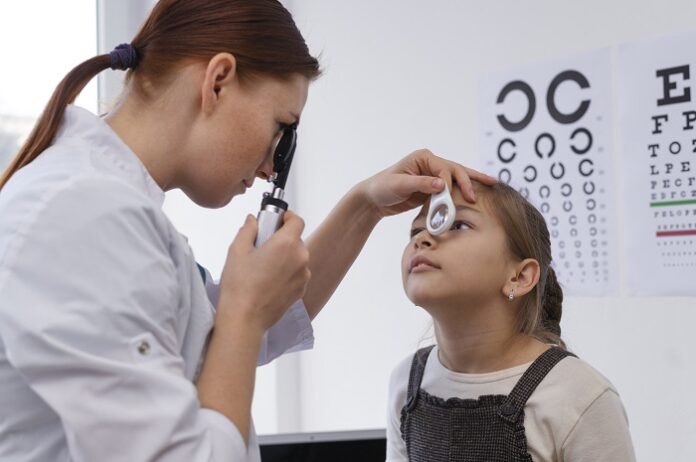A child’s ability to see is a basic human right. Yet, this luxury is still out of reach for countless youngsters in underdeveloped countries because of a silent but ruthless foe called pediatric cataracts. In addition to obstructing a child’s vision, these cloudy lenses cast a lengthy shadow over their lives, impeding their entire growth, education, and opportunities for the future.
Despite medical advances in cataract therapy, a sizable section of the pediatric population worldwide still struggles with this condition in areas with few resources, exacerbating their struggles.
The frequency of pediatric cataracts in developing countries is a long-standing problem, and this study explores the socioeconomic, infrastructure, and healthcare inequities that obstruct prompt and efficient treatment. By addressing these impediments, we aim to shine a light on creative strategies and activities to restore the vision and hope of youngsters who deserve a brighter future.
What are Pediatric Cataracts?
Many individuals believe that cataracts only affect the elderly. But, cataracts can also occur in children. Pediatric cataracts is the term used to describe cataracts in youngsters.
Cataracts occur in adults once the eyes and vision mature. Once the cataracts have been removed, the majority of adults once again have good eyesight. Before they become 8 or 10, children’s eyes and brains are still developing. Because of this, untreated cataracts can seriously and permanently impair a child’s vision.
What Are the Barriers to Curing Cataracts in Developing Nations?
Curing cataracts, a seemingly straightforward medical procedure in more affluent nations presents a complex web of barriers in the developing world. To truly understand these challenges, let’s humanize the issues faced by children and adults in these regions, as stated by the National Institute of Health:
Lack of Access to Healthcare
Many individuals in developing nations live in remote areas, far from medical facilities. The journey to access care is often arduous and costly, deterring those who need treatment. Some must travel for hours, even days, with limited resources.
Financial Hurdles
The expense of a cataract surgery may be daunting for families already having trouble affording essentials. It hurts to decide between providing for the family’s needs and getting medical attention. Also, understanding the financial implications is crucial when opting for the best laser eye surgery in London, particularly for those considering cataract surgery as part of their treatment plan.
Limited Knowledge
In some areas, there needs to be more knowledge regarding cataracts and how treatable they are. People might need to be made aware of the signs, and even if they are, myths and superstitions can confuse judgment, preventing timely medical attention.
Lack of Qualified Professionals
More qualified eye care professionals are needed across the globe especially, in underdeveloped countries. Due to their heavy workloads and inability to meet the voluminous demand for their services, these devoted experts are in great need.
Infrastructure Challenges
Inadequate medical facilities and outdated equipment hamper the quality and accessibility of eye care. Surgeries may be delayed, or complications can arise due to subpar conditions.
Cultural Beliefs
Cultural beliefs can create hesitation about seeking medical attention. Some communities may view cataracts as a part of aging or even a curse, adding an extra layer of resistance.
Postoperative Care
Cataract surgery involves more than simply the procedure. It might be difficult for patients in distant places to access the continued care necessary for a complete recovery.
How Do We Address These Barriers in the Developing Nations?
A multifaceted approach is required to cure the barriers obstructing cataract treatment in developing nations effectively. Here are some solutions:
- Community Education: Launch awareness campaigns that educate communities about cataracts, their symptoms, and the importance of early treatment. Work with local leaders to dispel myths and superstitions.
- Mobile Clinics: Establish mobile eye clinics that can reach remote areas, providing on-the-ground diagnosis and treatment options for those who cannot travel long distances.
- Financial Support: Develop subsidized or free cataract surgery programs supported by governments, NGOs, and philanthropic organizations to alleviate the financial burden on patients and their families.
- Healthcare Workforce Training: Invest in training local healthcare providers in cataract diagnosis and surgery, including doctors and nurses. This empowers communities to provide care independently.
- Infrastructure Improvement: Upgrade healthcare infrastructure and ensure the availability of essential surgical equipment and facilities, even in remote regions.
- Telemedicine: Implement telemedicine services to connect local healthcare workers with specialized eye doctors for consultations and guidance.
- Community Engagement: Involve local communities in the planning and implementation of healthcare programs to ensure cultural sensitivity and acceptance.
Tej Kohli and Ruit Foundation: Providing Colors and Smiles Worldwide
The Tej Kohli and Ruit Foundation is financially supported by Tej Kohli and his family. The amazing man behind it is Dr. Sanduk Ruit, who has operated on and healed thousands of individuals as part of this admirable project.
This charity was started to assist people in regaining their vision and recognizing the joyful hues of the outside world. The foundation has been conducting surveys in Ghana, Bhutan, Nepal, and other underdeveloped regions across the globe.
Not only did they make sure to start camps for fully sponsored procedures, but they also took care of the pre-and post-operative care. They educated people about the illness and made them aware of it.
The lenses, infrastructure, and medical facilities were all of the highest caliber. They have successfully closed the gap between cataract surgical facilities in impoverished and developed countries, and they are currently unstoppable.
Route to Take
It can be tough but vital to make an effort to lower difficulties in cataract therapy in developing countries. By spreading awareness, providing information, offering financial support, and participating in the community, we can assist those in need.
The Tej Kohli and Ruit Foundation enters the gap and improves lives through their outstanding efforts. We can create a world where no one has to deal with the misery of preventable blindness by working together.






